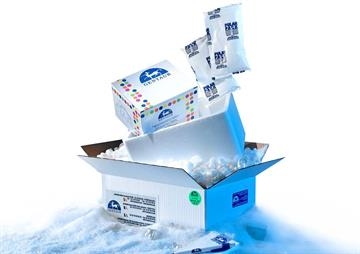IL-4 R alpha Recombinant Protein

IL-4 R alpha Recombinant Protein
1201.45 €
In Stock
quantity
product details
Catalog number: 223 - 96-796
Product Category: Business & Industrial > Science & Laboratory
ProSciGentaur
Size: 0.05 mg
Related Products
96-797
IL-4 R alpha Recombinant Protein
IL-4 is a pleiotropic cytokine produced by activated Th2 cells and mast cells, and plays a pivotal role in immune responses. The effects of IL-4 are mediated after binding to high affinity receptor complexes present on hematopoietic as well as non-hematopoietic cells. Hematopoietic cellular responses to IL-4 are mediated by a high affinity receptor complex comprised of the 140 kDa IL4Ralpha (CD124)subunit and the 70 kDa common cytokine γc chain (CD132).Interleukin 4 Receptor (IL4R) also known as CD124, IL4Ralpha and BSF receptor, is a type I cytokine receptor produced by activated Th2 cells and mast cells, and plays an important role in Th2-biased immune responses, alternative macrophage activation, mucosal immunity, allergic inflammation, tumor progression, and atherogenesis. A soluble form of the encoded IL4R protein can be produced by an alternate splice variant or by proteolysis of the membrane-bound protein, and this soluble form can inhibit IL4-mediated cell proliferation and IL5 upregulation by T-cells. IL4R can alternatively associate with IL13Ra1 to form the type II receptor which is responsive to both IL4 and IL13. Interleukin-4 receptor has been shown to interact with SHC1.
1059.7 €
97-007
IL-4 R alpha Recombinant Protein
IL-4 is a pleiotropic cytokine produced by activated Th2 cells and mast cells, and plays a pivotal role in immune responses. The effects of IL-4 are mediated after binding to high affinity receptor complexes present on hematopoietic as well as non-hematopoietic cells. Hematopoietic cellular responses to IL-4 are mediated by a high affinity receptor complex comprised of the 140 kDa IL4Ralpha (CD124)subunit and the 70 kDa common cytokine γc chain (CD132).Interleukin 4 Receptor (IL4R) also known as CD124, IL4Ralpha and BSF receptor, is a type I cytokine receptor produced by activated Th2 cells and mast cells, and plays an important role in Th2-biased immune responses, alternative macrophage activation, mucosal immunity, allergic inflammation, tumor progression, and atherogenesis. A soluble form of the encoded IL4R protein can be produced by an alternate splice variant or by proteolysis of the membrane-bound protein, and this soluble form can inhibit IL4-mediated cell proliferation and IL5 upregulation by T-cells. IL4R can alternatively associate with IL13Ra1 to form the type II receptor which is responsive to both IL4 and IL13. Interleukin-4 receptor has been shown to interact with SHC1.
1059.7 €
97-008
IL-4 R alpha Recombinant Protein
IL-4 is a pleiotropic cytokine produced by activated Th2 cells and mast cells, and plays a pivotal role in immune responses. The effects of IL-4 are mediated after binding to high affinity receptor complexes present on hematopoietic as well as non-hematopoietic cells. Hematopoietic cellular responses to IL-4 are mediated by a high affinity receptor complex comprised of the 140 kDa IL4Ralpha (CD124)subunit and the 70 kDa common cytokine γc chain (CD132).Interleukin 4 Receptor (IL4R) also known as CD124, IL4Ralpha and BSF receptor, is a type I cytokine receptor produced by activated Th2 cells and mast cells, and plays an important role in Th2-biased immune responses, alternative macrophage activation, mucosal immunity, allergic inflammation, tumor progression, and atherogenesis. A soluble form of the encoded IL4R protein can be produced by an alternate splice variant or by proteolysis of the membrane-bound protein, and this soluble form can inhibit IL4-mediated cell proliferation and IL5 upregulation by T-cells. IL4R can alternatively associate with IL13Ra1 to form the type II receptor which is responsive to both IL4 and IL13. Interleukin-4 receptor has been shown to interact with SHC1.
1059.7 €
11-325
IL-13 R alpha 2 Recombinant Protein
Interleukin-13 receptor subunit alpha-2 is also known as IL13Rα2, IL13Ra2 cluster of differentiation 213A2, CD213A2, CT19, IL-13R, IL13BP, and is a membrane bound protein that in humans is encoded by the IL13RA2 gene. IL13Rα2 is closely related to IL13Rα1, a subunit of the interleukin-13 receptor complex. This protein binds IL13 with high affinity, but lacks any significant cytoplasmic domain, and does not appear to function as a signal mediator. It is, however able to regulate the effects of both IL13 and IL4, despite the fact it is unable to bind directly to the latter. It is also reported to play a role in the internalization of IL13. IL13Rα2 is a component of the cell surface receptors, however, the majority exists in intracellular pools and in soluble form, and thus plays an opposite role as a potent IL13 antagonist compared with IL13Rα1. It also functions as an inhibitor of IL4-dependent pathway probably through the physical interaction between the short intracellular domain of and cytoplasmic domain of IL13Rα2 and the IL4Rα chain. In spite of the failed STAT signaling function, IL13Rα2 dose induce TGF-beta production and fibrosis. Additionally, IL13Rα2has been reported to be abundantly and specifically overexpressed in glioblastoma multiforme.
1106.95 €
11-347
IL-5 R alpha / CD125 Recombinant Protein
Interleukin-5 receptor subunit alpha (IL5RA) is also known as IL-5 receptor subunit alpha, IL-5R subunit alpha and CD125,which is a single-pass type I membrane protein that belongs to the type I cytokine receptor family and type 5 subfamily.IL5R, a heterodimer of an alpha and a beta subunit, is expressed on eosinophils and basophils. IL5RA / CD125 is the receptor for interleukin-5 (IL5) and the alpha chain can bind to IL5. The WSXWS motif of IL5RA appears to be necessary for proper protein folding and thereby efficient intracellular transport and cell-surface receptor binding.The beta subunit of IL5R is common to the IL3, IL5 and GM-CSF receptors.









